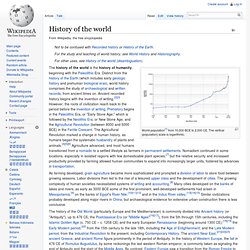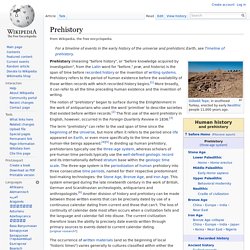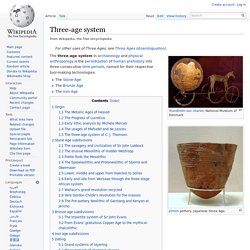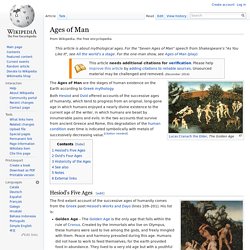History: a timeline
History of the world. World population[1] from 10,000 BCE to 2,000 CE.

The vertical (population) scale is logarithmic. The history of the world is the history of humanity, beginning with the Paleolithic Era.
Geological timescale. Subatlantic age. Prehistory. Prehistory (meaning "before history", or "before knowledge acquired by investigation", from the Latin word for "before," præ, and historia) is the span of time before recorded history or the invention of writing systems.

Prehistory refers to the period of human existence before the availability of those written records with which recorded history begins.[1] More broadly, it can refer to all the time preceding human existence and the invention of writing. The notion of "prehistory" began to surface during the Enlightenment in the work of antiquarians who used the word 'primitive' to describe societies that existed before written records.[2] The first use of the word prehistory in English, however, occurred in the Foreign Quarterly Review in 1836.[3] The occurrence of written materials (and so the beginning of local "historic times") varies generally to cultures classified within either the late Bronze Age or within the Iron Age.
Definition[edit] Stone Age[edit] Paleolithic[edit] uninhabited. Ancient history. Ancient history is the aggregate of past events[1] from the beginning of recorded human history to the Early Middle Ages or the Postclassical Era. The span of recorded history is roughly 5,000 years, with Sumerian Cuneiform script, the oldest discovered form of coherent writing, from the protoliterate period around the 30th century BC.[2] The term classical antiquity is often used to refer to history in the Old World from the beginning of recorded Greek history in 776 BC (First Olympiad).
This roughly coincides with the traditional date of the founding of Rome in 753 BC, the beginning of the history of ancient Rome, and the beginning of the Archaic period in Ancient Greece. In India, the period includes the early period of the Middle Kingdoms,[9][10][11] and, in China, the time up to the Qin Dynasty is included.[12][13] Study[edit] Historians have two major avenues which they take to better understand the ancient world: archaeology and the study of source texts.
Three-age system. The three-age system in archaeology and physical anthropology is the periodization of human prehistory into three consecutive time periods, named for their respective tool-making technologies: Jomon pottery, Japanese Stone Age.

Origin[edit] The concept of dividing pre-historical ages into systems based on metals extends far back in European history, but the present archaeological system of the three main ages: stone, bronze and iron, originates with the Danish archaeologist Christian Jürgensen Thomsen (1788–1865), who placed the system on a more scientific basis by typological and chronological studies, at first, of tools and other artifacts present in the Museum of Northern Antiquities in Copenhagen (later the National Museum of Denmark). He later used artifacts and the excavation reports published or sent to him by Danish archaeologists who were doing controlled excavations.
Ages of Man. The Ages of Man are the stages of human existence on the Earth according to Greek mythology.

Both Hesiod and Ovid offered accounts of the successive ages of humanity, which tend to progress from an original, long-gone age in which humans enjoyed a nearly divine existence to the current age of the writer, in which humans are beset by innumerable pains and evils. In the two accounts that survive from ancient Greece and Rome, this degradation of the human condition over time is indicated symbolically with metals of successively decreasing value.
[citation needed] Hesiod's Five Ages[edit]
Stone age 2.6 M-12 K BCE.
Bronze age 3.7K-300 BCE
Iron age 1.3 K BCE-50 AD. Axial age 800-200 BCE. Ancient Rome 510 BCE-480 AD. Middle ages 500-1500 AD. Age of discovery. Early Modern period. Age of Enlightenment. Age of Revolutions. Industrial Revolution. Contemporary history.




